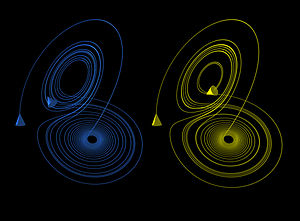Chaos Theory
General
[edit | edit source]
Chaos theory is a mathematical and scientific field dealing with complex systems. The basic idea of chaos theory is that, although the system in question is completely deterministic, meaning that every time a certain input is put in the exact same output will be produced without exception or random fluctuation, these systems may still display patterns that are completely unpredictable and never repeat. The reason this can be true is that these complex systems are highly sensitive to initial conditions. So even though, as stated above with the definition of "deterministic", input X will always produce output Y and never anything but output Y, two inputs that differ by only minute amounts can, over time, result in extremely different outputs. For instance, say when X=1, then Y=13. However, when X=1.00001, then Y=42. In this example, it is clear that a very minute and seemingly inconsequential difference in inputs generates vastly different results. Such extreme sensitivity is an explanation for the widely-known idea of the "butterfly effect", wherein the minute changes in airflow resulting from the flap of a butterfly's wings leads to a cascade of changes that may decide whether a hurricane will form or not
In light of this, the scientific implications of chaos theory are immediately apparent. Although the precise deterministic formula for calculating and predicting what a system's state will be given the values for all the formula's variables may be known, it is virtually impossible to ensure that the measured values for all the variables being inserted into that formula are exact. If they are not absolutely exact, be it because of unavoidable measurement error or whatever else, then minute changes in the formula's initial conditions will manifest themselves into substantial differences in that formula's predictions. Thus such systems are, in effect, unpredictable in practice by the tools of modern science even though the formula for the system gives in perfectly predictable results in theory.
Example
[edit | edit source]
For a visualization of chaos theory, imagine a ball to the right of a stretch of hills. If someone where to push this ball, depending on the force of the push it would roll up a hill, and either stop partway up and go back down due to a loss of momentum or pass the top of the hill and then either fail to pass the next hill and wind up in the trough between hills or pass that next hill, etc. Given the force of that initial push and the mass of the ball, a physicist could predict with perfect accuracy which trough between hills the ball will end up. Based on that force, the physicist could say the ball will only make it past the first hill and wind up in that trough, or go past three hills, etc. In fact, the physicist's predictions here are fairly forgiving of initial conditions- if the pass of the ball is not entirely accurate, or the force measurement is a little bit off, or even if all the effects of wind resistance and friction are ignored- the physicist should still come up with the correct answer. However now imagine that the ball was pushed with just enough force so that it teeters on the very top of a hill. Here the physicist's predictions can come into doubt, and chaos theory sets in. It will only take the slightest difference to determine whether that ball rolls back down where it came or roles on to the next hill. Just a minute difference in the amount of force in the push, or a capricious gust of air will now be responsible for determining how this system ends up. In this case it is clear that the system is highly sensitive to initial conditions and the physicist's previously unquestionable predictions now become little more than guesses.
